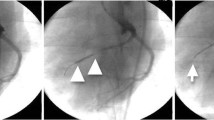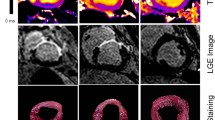Abstract
To study the feasibility of a myocardial infarct (MI) quantification method [signal intensity-based percent infarct mapping (SI-PIM)] that is able to evaluate not only the size, but also the density distribution of the MI. In 14 male swine, MI was generated by 90 min of closed-chest balloon occlusion followed by reperfusion. Seven (n = 7) or 56 (n = 7) days after reperfusion, Gd-DTPA-bolus and continuous-infusion enhanced late gadolinium enhancement (LGE) MRI, and R1-mapping were carried out and post mortem triphenyl-tetrazolium-chloride (TTC) staining was performed. MI was quantified using binary [2 or 5 standard deviation (SD)], SI-PIM and R1-PIM methods. Infarct fraction (IF), and infarct-involved voxel fraction (IIVF) were determined by each MRI method. Bias of each method was compared to the TTC technique. The accuracy of MI quantification did not depend on the method of contrast administration or the age of the MI. IFs obtained by either of the two PIM methods were statistically not different from the IFs derived from the TTC measurements at either MI age. IFs obtained from the binary 2SD method overestimated IF obtained from TTC. IIVF among the three different PIM methods did not vary, but with the binary methods the IIVF gradually decreased with increasing the threshold limit. The advantage of SI-PIM over the conventional binary method is the ability to represent not only IF but also the density distribution of the MI. Since the SI-PIM methods are based on a single LGE acquisition, the bolus-data-based SI-PIM method can effortlessly be incorporated into the clinical image post-processing procedure.







Similar content being viewed by others

References
Karamitsos TD, Francis JM, Myerson S, Selvanayagam JB, Neubauer S (2009) The role of cardiovascular magnetic resonance imaging in heart failure. J Am Coll Cardiol 54(15):1407–1424. doi:10.1016/j.jacc.2009.04.094
Schuleri KH, Centola M, George RT, Amado LC, Evers KS, Kitagawa K, Vavere AL, Evers R, Hare JM, Cox C, McVeigh ER, Lima JA, Lardo AC (2009) Characterization of peri-infarct zone heterogeneity by contrast-enhanced multidetector computed tomography: a comparison with magnetic resonance imaging. J Am Coll Cardiol 53(18):1699–1707. doi:10.1016/j.jacc.2009.01.056
Surányi P, Kiss P, Brott BC, Simor T, Elgavish A, Ruzsics B, Saab-Ismail NH, Elgavish GA (2006) Percent infarct mapping: an R1-map-based CE-MRI method for determining myocardial viability distribution. Magn Reson Med 56(3):535–545. doi:10.1002/mrm.20979
Flett AS, Hayward MP, Ashworth MT, Hansen MS, Taylor AM, Elliott PM, McGregor C, Moon JC (2010) Equilibrium contrast cardiovascular magnetic resonance for the measurement of diffuse myocardial fibrosis: preliminary validation in humans. Circulation 122(2):138–144. doi:10.1161/CIRCULATIONAHA.109.930636
Moran G, Thornhill R, Sykes J, Prato F (2002) Myocardial viability imaging using Gd-DTPA: physiological modeling of infarcted myocardium, and impact on injection strategy and imaging time. Magn Reson Med 48(5):791–800. doi:10.1002/mrm.10289
Kirschner R, Varga-Szemes A, Brott BC, Litovsky S, Elgavish A, Elgavish GA, Simor T (2011) Quantification of myocardial viability distribution with Gd(DTPA) bolus-enhanced, signal intensity-based percent infarct mapping. Magn Reson Imaging 29(5):650–658. doi:10.1016/j.mri.2011.02.010
Simor T, Suranyi P, Ruzsics B, Toth A, Toth L, Kiss P, Brott BC, Varga-Szemes A, Elgavish A, Elgavish GA (2010) Percent infarct mapping for delayed contrast enhancement magnetic resonance imaging to quantify myocardial viability by Gd(DTPA). J Magn Reson Imaging 32(4):859–868. doi:10.1002/jmri.22296
Wu KC (2012) CMR of microvascular obstruction and hemorrhage in myocardial infarction. J Cardiovasc Magn Reson 14:68. doi:10.1186/1532-429X-14-68
Canet D, Levy GC, Peat IR (1975) Time saving in 13C spin-lattice relaxation measurements by inversion-recovery. J Magn Reson 18:199–204. doi:10.1016/0022-2364(75)90238-3
Kaldoudi E, Williams SCR (1993) Relaxation time measurements in NMR imaging. Part I: Longitudinal relaxation time. Concepts Magn Reson 5:217–242. doi:10.1002/cmr.1820050303
Fishbein M, Meerbaum S, Rit J, Lando U, Kanmatsuse K, Mercier J, Corday E, Ganz W (1981) Early phase acute myocardial infarct size quantification: validation of the triphenyl tetrazolium chloride tissue enzyme staining technique. Am Heart J 101(5):593–600
White SK, Sado DM, Fontana M, Banypersad SM, Maestrini V, Flett AS, Piechnik SK, Robson MD, Hausenloy DJ, Sheikh AM, Hawkins PN, Moon JC (2013) T1 mapping for myocardial extracellular volume measurement by CMR: bolus only versus primed infusion technique. J Am Coll Cardiol Imaging 6(9):955–962. doi:10.1016/j.jcmg.2013.01.011
Beek AM, Kuhl HP, Bondarenko O, Twisk JW, Hofman MB, van Dockum WG, Visser CA, van Rossum AC (2003) Delayed contrast-enhanced magnetic resonance imaging for the prediction of regional functional improvement after acute myocardial infarction. J Am Coll Cardiol 42(5):895–901. doi:10.1016/S0735-1097(03)00835-0
Bondarenko O, Beek AM, Hofman MBM, Kuhl HP, Twisk JWR, van Dockum WG, Visser CA, van Rossum AC (2005) Standardizing the definition of hyperenhancement in the quantitative assessment of infarct size and myocardial viability using delayed contrast-enhanced CMR. J Cardiovasc Magn Reson 7(2):481–485. doi:10.1081/Jcmr-200053623
Amado LC, Gerber BL, Gupta SN, Rettmann DW, Szarf G, Schock R, Nasir K, Kraitchman DL, Lima JA (2004) Accurate and objective infarct sizing by contrast-enhanced magnetic resonance imaging in a canine myocardial infarction model. J Am Coll Cardiol 44(12):2383–2389. doi:10.1016/j.jacc.2004.09.020
Fieno DS, Kim RJ, Chen EL, Lomasney JW, Klocke FJ, Judd RM (2000) Contrast-enhanced magnetic resonance imaging of myocardium at risk: distinction between reversible and irreversible injury throughout infarct healing. J Am Coll Cardiol 36(6):1985–1991. doi:10.1016/S0735-1097(00)00958-X
Wetstein L, Mark R, Kaplinsky E, Mitamura H, Kaplan A, Sauermelch C, Michelson E (1985) Histopathologic factors conducive to experimental ventricular tachycardia. Surgery 98(3):532–539
Heiberg E, Ugander M, Engblom H, Gotberg M, Olivecrona GK, Erlinge D, Arheden H (2008) Automated quantification of myocardial infarction from MR images by accounting for partial volume effects: animal, phantom, and human study. Radiology 246(2):581–588. doi:10.1148/radiol.2461062164
Schmidt A, Azevedo CF, Cheng A, Gupta SN, Bluemke DA, Foo TK, Gerstenblith G, Weiss RG, Marban E, Tomaselli GF, Lima JAC, Wu KC (2007) Infarct tissue heterogeneity by magnetic resonance imaging identifies enhanced cardiac arrhythmia susceptibility in patients with left ventricular dysfunction. Circulation 115(15):2006–2014. doi:10.1161/circulationaha.106.653568
Yan AT, Shayne AJ, Brown KA, Gupta SN, Chan CW, Luu TM, Di Carli MF, Reynolds HG, Stevenson WG, Kwong RY (2006) Characterization of the Peri-infarct zone by contrast-enhanced cardiac magnetic resonance imaging is a powerful predictor of post-myocardial infarction mortality. Circulation 114(1):32–39. doi:10.1161/CIRCULATIONAHA.106.613414
Messroghli D, Radjenovic A, Kozerke S, Higgins D, Sivananthan M, Ridgway J (2004) Modified look-locker inversion recovery (MOLLI) for high-resolution T1 mapping of the heart. Magn Reson Med 52(1):141–146. doi:10.1002/mrm.20110
Messroghli DR, Greiser A, Frohlich M, Dietz R, Schulz-Menger J (2007) Optimization and validation of a fully-integrated pulse sequence for modified look-locker inversion-recovery (MOLLI) T1 mapping of the heart. J Magn Reson Imaging 26(4):1081–1086. doi:10.1002/jmri.21119
Messroghli DR, Walters K, Plein S, Sparrow P, Friedrich MG, Ridgway JP, Sivananthan MU (2007) Myocardial T1 mapping: application to patients with acute and chronic myocardial infarction. Magn Reson Med 58(1):34–40. doi:10.1002/mrm.21272
Piechnik SK, Ferreira VM, Dall’Armellina E, Cochlin LE, Greiser A, Neubauer S, Robson MD (2010) Shortened modified look-locker inversion recovery (ShMOLLI) for clinical myocardial T1-mapping at 1.5 and 3 T within a 9 heartbeat breathhold. J Cardiovasc Magn Reson 12:69. doi:10.1186/1532-429X-12-69
Acknowledgments
This study was supported by the National Institutes of Health, National Heart, Lung and Blood Institute (Grant# 5R42 HL080886).
Conflict of interest
A.V.S. and Z.L. are employees, R.K. and L.T. were employees, T.S. is consultant, and A.E. and G.A.E. are officers and consultants, of Elgavish Paramagnetics Inc.
Author information
Authors and Affiliations
Corresponding author
Rights and permissions
About this article
Cite this article
Varga-Szemes, A., Simor, T., Lenkey, Z. et al. Infarct density distribution by MRI in the porcine model of acute and chronic myocardial infarction as a potential method transferable to the clinic. Int J Cardiovasc Imaging 30, 937–948 (2014). https://doi.org/10.1007/s10554-014-0408-x
Received:
Accepted:
Published:
Issue Date:
DOI: https://doi.org/10.1007/s10554-014-0408-x



